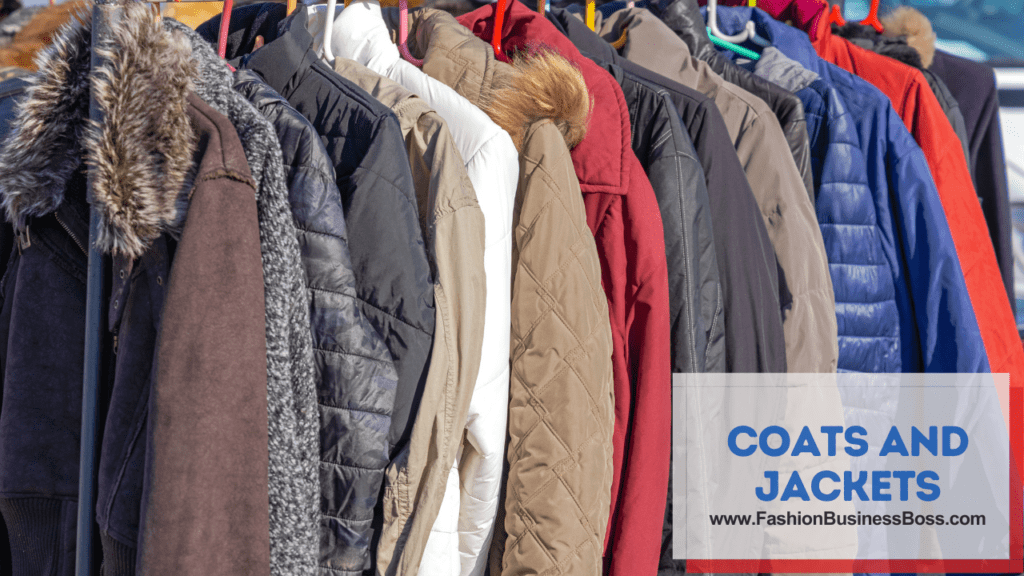Starting a clothing line is an exciting venture. The number of designs you should start with can vary depending on your budget, target audience, and overall business strategy.
Here are some recommendations for designing your clothing line: winter collection including 3-4 coats, 3-4 sweaters, 2-3 scarves, 2-3 pants, and 2-3 dresses. Then, expand into other seasons with specific design numbers for each category, ensuring variety and market appeal.
In this article, we will discuss the importance of starting your clothing line with a carefully curated selection of designs.
Coats and Jackets

When starting your clothing line, it’s wise to begin with a limited but diverse range of designs for each category. For Coats and Jackets, consider offering 3-4 different styles tailored for winter. These should include various lengths, cuts, and materials to cater to different tastes.
Next, for Sweaters, having 3-4 designs with a mix of patterns and materials ensures variety. This allows your customers to choose based on their style and warmth preferences.
In the category of Scarves and Accessories, having 2-3 designs is enough to provide options for complementing winter outfits. These may include scarves, gloves, and other winter accessories.
For Pants and Leggings, offering 2-3 designs designed for winter conditions covers the basics. Include different fits and materials for versatility.
Lastly, for Dresses, 2-3 designs suitable for colder weather, perhaps with long sleeves or thicker fabrics, should suffice.
Expanding into other seasons requires thoughtful planning. For Spring/Summer, focus on lightweight clothing like dresses, shorts, t-shirts, and swimwear, with a range of 10-15 designs. In the Fall, create another collection of 10-15 designs, featuring transitional pieces like cardigans, long-sleeve tops, and light jackets. This approach ensures you have a well-rounded clothing line throughout the year.
Read more about: Fashioning a Future: Calculating Your Clothing Business Expenses
Spring/Summer
When transitioning into the Spring/Summer season, it’s essential to plan your clothing line carefully. Begin by creating a collection of 10-15 designs that are specifically tailored to the warmer weather.
Consider including lightweight clothing items such as dresses, shorts, t-shirts, and swimwear. These designs should align with the preferences and needs of your target market. Think about the style and comfort that your customers seek during the Spring and Summer months.
Dresses can feature breathable fabrics and cheerful patterns, while shorts should provide a comfortable fit for outdoor activities. T-shirts should be made from light materials to keep wearers cool, and swimwear designs should be stylish and functional for trips to the beach or pool.
By offering a well-thought-out selection of 10-15 designs for the Spring/Summer season, you cater to the seasonal demands of your customers, ensuring that your clothing line remains relevant and appealing throughout the warmer months. This approach allows you to meet the changing needs of your audience while expanding your brand’s offerings.
Fall
As the Fall season approaches, it’s important to adapt your clothing line accordingly. To do this effectively, you should develop a collection of 10-15 designs that cater to the transitional nature of this season.
In this collection, focus on creating clothing items like cardigans, long-sleeve tops, and light jackets. These pieces serve as the perfect transition from the warmer summer months to the cooler days of Fall.
Cardigans offer versatility, allowing your customers to layer and adjust their clothing for comfort as temperatures fluctuate. Long-sleeve tops provide additional warmth, while light jackets are essential for protection against chilly breezes without being too heavy.
Consider using fabrics and materials that offer both comfort and style, keeping in mind the changing weather conditions. Earthy tones and autumn-inspired patterns can also enhance the appeal of your Fall collection.
By offering 10-15 carefully designed transitional pieces, you ensure that your clothing line remains relevant and meets the needs of your customers as they transition into the Fall season. This thoughtful approach helps you maintain a well-rounded and seasonally appropriate product range.
Holiday Collections

When considering holiday collections for your clothing line, it’s important to plan thoughtfully. You can begin by creating approximately 10-15 unique designs for each major holiday-themed collection.
For each holiday, whether it’s Christmas, Valentine’s Day, Halloween, or others, tailor your designs to reflect the spirit and theme of that particular holiday. This might include incorporating holiday-specific colors, patterns, and motifs.
For example, for a Christmas-themed collection, you can design clothing with festive colors like red and green, and include patterns like snowflakes or reindeer. Valentine’s Day collections might feature romantic reds and pinks with heart-themed patterns, while Halloween could embrace dark, spooky colors and costume-inspired designs.
These holiday-themed collections provide your customers with the opportunity to celebrate special occasions in style. By offering 10-15 unique designs per holiday, you provide a variety of choices, ensuring that your customers can find the perfect outfit to celebrate and enjoy these festive times of the year.
Read more about: From Design to Display: Clothing Brand Equipment
Athleisure and Activewear
When venturing into the athleisure and activewear category, careful planning is essential. It’s advisable to begin by offering a collection of 15-20 designs that encompass a range of workout tops, bottoms, and accessories.
In this collection, focus on providing a variety of options to cater to different workout preferences and activities. For workout tops, you can include t-shirts, tank tops, and sports bras in various styles and fits. In the category of bottoms, consider leggings, shorts, and joggers, each designed for comfort and performance.
Accessories like headbands, wristbands, and workout bags can complement the clothing line, providing functional and stylish additions to your athleisure and activewear offerings.
It’s important to use moisture-wicking and breathable fabrics to ensure comfort during physical activities. Prioritize functionality and durability to meet the demands of an active lifestyle.
Seasonal Accessories
When considering seasonal accessories, it’s important to create a well-rounded offering that complements your clothing collections. To do this effectively, you can begin by developing a range of 10-15 accessory designs for each season.
These accessories can include items like hats, bags, and jewelry that align with the seasonal theme and fashion trends. For instance, in the summer, you might design straw hats, beach bags, and lightweight, vibrant jewelry to complement warm-weather clothing.
In the fall and winter, you can shift towards cozy knit hats, scarves, and bags with earthy tones to match the season’s colors and provide warmth and style.
By offering 10-15 accessory designs for each season, you ensure that your customers have options to complete their outfits. These accessories not only enhance the overall look but also offer practicality and functionality.
Remember to keep an eye on seasonal trends and customer preferences to guide your accessory design choices. This approach allows you to create a well-rounded product line that appeals to your target market’s needs and preferences throughout the year.
Children’s and Family Lines

When considering children’s and family clothing lines, it’s important to take a thoughtful approach. To start, create an initial collection of 10-15 children’s clothing designs, ensuring you cover a range of styles and sizes to cater to different age groups and preferences.
As you gather feedback and gauge demand, gradually expand your children’s clothing line. Keep a close eye on market trends and the specific needs of parents and children to guide your expansion efforts effectively.
Family clothing lines often involve coordinating outfits for various family members. The number of designs needed for these coordinated ensembles will depend on the scope of your offerings. For instance, coordinating outfits may encompass matching tops, bottoms, or accessories for parents and children. You can commence with a modest selection and then expand as your brand gains momentum.
The key is to uphold the quality and attractiveness of your designs while accommodating the desires of families seeking coordinated or matching attire. This approach enables you to develop a children’s and family clothing line that meets your target audience’s needs while ensuring growth based on demand.
Read more about: From Fabric to Fame: Design and Sell Your Own Clothes
Plus Size and Inclusive Collections
When considering plus-size and inclusive collections, your aim should be to offer a variety of designs that cater to a diverse range of individuals. To begin, it’s advisable to create an initial collection that includes 10-15 styles for each specific collection.
In this collection, focus on providing designs that not only accommodate different body sizes but also celebrate various tastes and preferences. Ensure that the clothing is comfortable, stylish, and flattering for individuals of all shapes and sizes.
As you gather feedback and gain a better understanding of the needs of your target audience, you can expand your plus-size and inclusive collections accordingly. It’s important to remain attuned to evolving fashion trends and the specific desires of your customers to guide your expansion efforts effectively.
The key is to offer a range of styles that promote inclusivity and diversity, ensuring that everyone can find clothing that fits their unique style and body type. This approach allows you to build a plus-size and inclusive clothing line that truly embraces and celebrates the diversity of your customer base.
Vintage or Retro Collections
When delving into vintage or retro collections, the starting point should be the creation of 10-15 designs that authentically represent the fashion trends of the chosen era.
These designs should encapsulate the essence of that specific time period, from the fabric choices to the silhouettes and patterns. It’s essential to conduct thorough research to ensure accuracy and authenticity in capturing the spirit of the era.
For instance, if you’re inspired by the 1960s, your designs might incorporate elements like A-line dresses, bold patterns, and psychedelic colors. If the 1980s serve as your muse, you could consider shoulder pads, neon hues, and oversized silhouettes.
By offering 10-15 carefully crafted designs that pay homage to the era you’ve chosen, you provide your customers with a nostalgic journey through fashion history. These pieces should resonate with individuals who appreciate the unique style and charm of that specific time period. This approach allows you to create a vintage or retro collection that speaks to the hearts of those who admire the fashion of bygone eras.
Limited-Edition Drops

When it comes to limited-edition drops, the focus is on offering a select number of unique pieces to create an aura of exclusivity and generate heightened demand. While the precise number of designs can fluctuate, it’s often advisable to start with a smaller collection containing 5-10 distinct pieces.
These limited-edition designs should be carefully curated to showcase creativity and uniqueness. They may incorporate special materials, innovative concepts, or exclusive collaborations to capture the attention of your audience.
The goal of limited-edition drops is to create anticipation and a sense of rarity among your customers. By limiting the quantity of these designs, you encourage a swift response from those who value exclusivity and wish to own a one-of-a-kind item.
By offering this smaller, handpicked collection, you stimulate excitement and demand within your customer base, ultimately enhancing the desirability of your brand and products. This approach allows you to tap into the appeal of limited-edition releases and maintain a dynamic and engaging relationship with your audience.
Read more about: From Fabric to Fashion: Calculating the Cost of Clothing Production
Conclusion
Remember that quality is essential. It’s better to have a smaller collection of well-designed and well-made pieces than a larger collection of subpar items. As your clothing line grows, you can gradually expand your offerings and explore new styles and seasons based on market demand and trends.
Frequently Asked Questions

Q: What is the typical starting budget for launching a clothing line?
A: The starting budget for a clothing line can vary significantly depending on factors like the scale of production, marketing strategy, and design complexity. It’s advisable to conduct a thorough business plan to determine your specific budget requirements.
Q: How do I choose the right target audience for my clothing line?
A: Selecting the right target audience involves market research. Identify demographics, preferences, and lifestyle factors that align with your brand’s vision. Understanding your potential customers will guide your design and marketing decisions.
Q: What are the key considerations when expanding into different seasons and collections?
A: Expanding into different seasons and collections requires planning. Consider factors such as season-specific clothing needs, market trends, and production capabilities. Start with a manageable number of designs and gradually expand as your brand grows.
Q: How can I ensure the quality of my clothing line’s designs?
A: Quality assurance is essential. Work closely with experienced designers, pattern makers, and manufacturers. Conduct quality control inspections throughout the production process to maintain high standards in materials, craftsmanship, and finish.
Q: What marketing strategies can help my clothing line grow in a competitive market?
A: Effective marketing involves a combination of online and offline strategies. Utilize social media, e-commerce platforms, influencer collaborations, and participate in trade shows or fashion events to promote your brand. Building a strong online presence and brand identity is crucial for growth.
To learn more about starting your own clothing business, check out my startup documents here.
Please note that the contents of this blog are for informational and entertainment purposes only and should not be construed as legal advice. Any action taken based on the information provided in this blog is solely at your own risk. Additionally, all images used in this blog are generated under the CC0 license of Creative Commons, which means they are free to use for any purpose without attribution.

Meet Shawn Chun: Entrepreneur and Fashion Business Fan.
I’m a happy individual who happens to be an entrepreneur. I have owned several types of businesses in my life from a coffee shop to an import and export business to an online review business plus a few more and now I create online resources for those interested in starting new ventures. It’s demanding work but I love it. I do it for those passionate about their business and their goals. That’s why when I meet a designer or boutique owner at a craft fair, farmers market, retail location or anywhere else I see myself. I know how hard the struggle is to retain clients, find good employees and keep the business growing all while trying to stay competitive.
That’s why I created Fashion Business Boss: I want to help fashion business owners like you build a thriving business that brings you endless joy and supports your ideal lifestyle.

